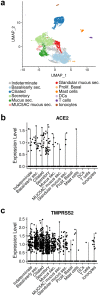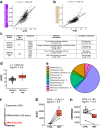This is a preprint.
Type 2 and interferon inflammation strongly regulate SARS-CoV-2 related gene expression in the airway epithelium
- PMID: 32511326
- PMCID: PMC7239056
- DOI: 10.1101/2020.04.09.034454
Type 2 and interferon inflammation strongly regulate SARS-CoV-2 related gene expression in the airway epithelium
Update in
-
Type 2 and interferon inflammation regulate SARS-CoV-2 entry factor expression in the airway epithelium.Nat Commun. 2020 Oct 12;11(1):5139. doi: 10.1038/s41467-020-18781-2. Nat Commun. 2020. PMID: 33046696 Free PMC article.
Abstract
Coronavirus disease 2019 (COVID-19) outcomes vary from asymptomatic infection to death. This disparity may reflect different airway levels of the SARS-CoV-2 receptor, ACE2, and the spike protein activator, TMPRSS2. Here we explore the role of genetics and co-expression networks in regulating these genes in the airway, through the analysis of nasal airway transcriptome data from 695 children. We identify expression quantitative trait loci (eQTL) for both ACE2 and TMPRSS2, that vary in frequency across world populations. Importantly, we find TMPRSS2 is part of a mucus secretory network, highly upregulated by T2 inflammation through the action of interleukin-13, and that interferon response to respiratory viruses highly upregulates ACE2 expression. Finally, we define airway responses to coronavirus infections in children, finding that these infections upregulate IL6 while also stimulating a more pronounced cytotoxic immune response relative to other respiratory viruses. Our results reveal mechanisms likely influencing SARS-CoV-2 infectivity and COVID-19 clinical outcomes.
Figures






References
Publication types
Grants and funding
- R01 ES015794/ES/NIEHS NIH HHS/United States
- HHSN268201600032C/ES/NIEHS NIH HHS/United States
- R01 HL141992/HL/NHLBI NIH HHS/United States
- U01 HL120393/HL/NHLBI NIH HHS/United States
- UM1 HG008901/HG/NHGRI NIH HHS/United States
- R01 HL141845/HL/NHLBI NIH HHS/United States
- HHSN268201800001C/HL/NHLBI NIH HHS/United States
- U01 HG009080/HG/NHGRI NIH HHS/United States
- R01 HL128439/HL/NHLBI NIH HHS/United States
- R01 HL117626/HL/NHLBI NIH HHS/United States
- U24 HG008956/HG/NHGRI NIH HHS/United States
- U01 HL138626/HL/NHLBI NIH HHS/United States
- R01 HL120393/HL/NHLBI NIH HHS/United States
- P01 HL107202/HL/NHLBI NIH HHS/United States
- K01 HL140218/HL/NHLBI NIH HHS/United States
- R01 HL135156/HL/NHLBI NIH HHS/United States
- T32 GM007546/GM/NIGMS NIH HHS/United States
- R01 HL117004/HL/NHLBI NIH HHS/United States
- P60 MD006902/MD/NIMHD NIH HHS/United States
- P01 HL132821/HL/NHLBI NIH HHS/United States
- R01 MD010443/MD/NIMHD NIH HHS/United States
LinkOut - more resources
Full Text Sources
Molecular Biology Databases
Miscellaneous
